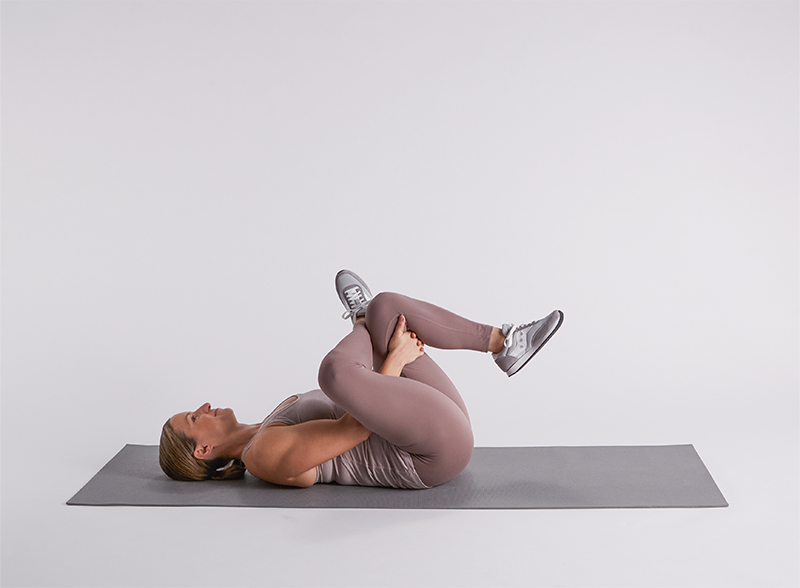How to Do a Figure Four Stretch: A Hinge Health Guide
Learn how to do a figure four stretch to improve lower body mobility and flexibility, plus modifications to make this exercise easier or harder.
Table of Contents
The figure four stretch is a great exercise to do when you feel a little tightness or tension in your hips and lower back. You can even try it first thing in the morning when you’re lying in bed. It loosens up your back, hip, and pelvic muscles, which may reduce pain, improve mobility and help you feel ready to take on the day.
Tap into pain relief. Anytime, anywhere with our app.
Our Hinge Health Experts
Dylan Peterson, PT, DPT
What Is a Figure Four Stretch?
The figure four stretch involves lying on your back and crossing one ankle over the opposite knee. Then you gently pull that leg toward your chest until you feel a good stretch in your hips and glutes.
What Muscles Does a Figure Four Stretch Work?
Glutes. The figure four stretch helps release tension in your butt muscles — particularly your gluteus medius, a muscle that’s located on the side of your hip that aids in hip mobility and stability.
Piriformis. This small but important muscle is located deep in your glutes. It can be a tricky muscle to stretch, which is where the figure four exercise comes in.
Benefits of Figure Four Stretch
Less back pain. Staying active in general may reduce back pain, but stretches like the figure four may be particularly beneficial by easing muscle tightness in this area.
Improved sciatica symptoms. Research shows that stretching your piriformis muscle can help reduce back and sciatica pain as well as increase mobility in the hip joints.
Better flexibility and range of motion. This exercise stretches your hips and back. Boosting your flexibility has been shown to improve your mobility and make everyday tasks feel easier for you.
Figure Four Stretch: Exercises and Modifications
The information contained in these videos is intended to be used for educational purposes only and does not constitute medical advice or treatment for any specific condition. Hinge Health is not your healthcare provider and is not responsible for any injury sustained or exacerbated by your use of or participation in these exercises. Please consult with your healthcare provider with any questions you may have about your medical condition or treatment.
Figure Four Stretch
Figure Four Stretch
Figure Four Stretch
Figure Four Stretch
To do a figure four stretch:
Lie on your back on a yoga mat with your knees bent and your feet flat on the floor. Bend one leg and place your ankle on your opposite knee.
Now grasp the back of your thigh or the front of your knee (of the leg on the floor) and gently pull your knee toward you. Your foot will lift off the floor as you hold this stretch.
Release your foot back to the floor to return to the starting position.
Repeat this exercise on the opposite side.
As you do each rep, you might feel a stretch in your hip muscles and the back of your leg.
It’s always helpful to listen to your body so let's look at how to make Figure 4 stretch easier, or more challenging.
Physical therapy (PT) is for more than just recovering from surgery or injury. It’s one of the top treatments for joint and muscle pain. It helps build strength, improve mobility, and reduce pain. And it doesn't always need to be in person.
Hinge Health members can conveniently access customized plans or chat with their care team at home or on the go — and experience an average 68% reduction in pain* within the first 12 weeks of their program. Learn more*.
Figure Four Stretch Modifications
Figure Four Stretch Modifications
Figure Four Stretch Modifications
Figure Four Stretch Modifications
To make a figure four easier:
After placing your ankle on your opposite knee, slide your heel as close to your butt as you are able and hold the stretch as your foot remains on the floor.
To make a figure four harder:
As you pull your knee toward you, use one hand to gently apply pressure to the raised knee to increase the stretch.
How Hinge Health Can Help You
If you have joint or muscle pain that makes it hard to move, you can get the relief you’ve been looking for with Hinge Health’s online exercise therapy program.
The best part: You don’t have to leave your home because our program is digital. That means you can easily get the care you need through our app, when and where it works for you.
Through our program, you’ll have access to therapeutic exercises and stretches for your condition. Additionally, you’ll have a personal care team to guide, support, and tailor our program to you.
See if you qualify for Hinge Health and confirm free coverage through your employer or benefit plan here.
This article and its contents are provided for educational and informational purposes only and do not constitute medical advice or professional services specific to you or your medical condition.
Looking for pain relief? Check if your employer or health plan covers our program
References
Park, J. C., et al. (2017). The Effects of Three Types of Piriform Muscle Stretching on Muscle Thickness and the Medial Rotation Angle of the Coxal Articulation. Journal of Physical Therapy Science, vol. 29, no. 10, pp. 1811–1814. doi:10.1589/jpts.29.1811
Ahmad S., et al. (2022). Physiotherapy for Piriformis Syndrome Using Sciatic Nerve Mobilization and Piriformis Release. Cureus, vol. 14, no. 12. doi:10.7759/cureus.32952
Turci, A. M., et al. (2023). Self-Administered Stretching Exercises Are as Effective as Motor Control Exercises for People with Chronic Non-Specific Low Back Pain: A Randomised Trial. Journal of Physiotherapy, vol. 69, no. 2, pp. 93–99. doi:10.1016/j.jphys.2023.02.016
